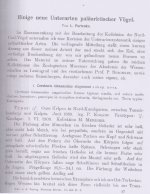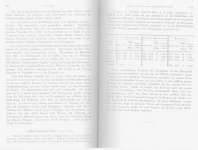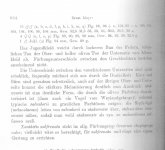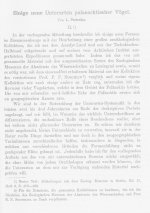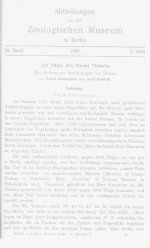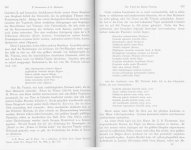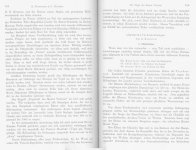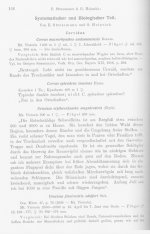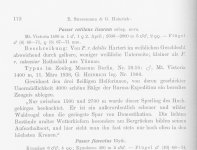Björn Bergenholtz
(former alias "Calalp")

Mitteilungen aus dem Zoologischen Museum in Berlin
James, here´s three of the missing ones of those Mitteilungen aus dem Zoologischen Museum in Berlin …with some small additional info:
● "1931 Pinicola enucleator stschur Portenko, 17, p. 422" … is found in: Portenko, L [= Portenko, Leonid Aleksandrovich (1896-1972) a k a Портенко Леонид Александрович]. 1931. Einige neue Unterarten paleärktischer Vögel. Mitteilungen aus dem Zoologischen Museum in Berlin 17 (3): 415-423. (attached, pp. 415 & 422-423)
… as solved by "mb1848" and Laurent in Post No. #12-14, well done!)
● "1931 Xanthotis subfrenata kingwalip Mayr, 17, p. 663" … is found in: Mayr, E. 1931. Die Vögel des Saruwaged- und Herzoggebirge (NO-Neuguinea). Mitteilungen aus dem Zoologischen Museum in Berlin 17 (5): 639-723. (Attached, p. 663 & 664)
= "(Kingwalip ist der Name des Vogels in der Hupe-Sprache (Ogeramnang))."
… meaning: "Kingwalip is the name on [these?] birds in the "Hupe" [?] Language, [in the Village] Ogeramnang"* … Voila!
*"Dorfe Ogeramnang (1785 m)", in North Eastern Papua New Guinea, mentioned in the Introduction of the same article, where the type was collected, in the Spring, between the 21st of March and the 1st April, of 1929].
● "1937 Uria lomvia eleonorae Portenko, 22, p. 227" … is found in: Portenko, L [as above]. 1937. Einige neue Unterarten palearktischer Vögel. Mitteilungen aus dem Zoologischen Museum in Berlin 22 (2): 219-229. (first page attached)
... see Michael's Post No. #19. (Well found, Michael!) … "I name it in honor of my daughter, who was born on a steamboat in the Bering Sea".
If born at the same time as the bird was discovered she was born in 1902. And (here I´m only speculating); could her maiden name possibly, maybe have been Elena (transformed alt. latinized to Eleonora) Portenka?
Who knows?
James, here´s three of the missing ones of those Mitteilungen aus dem Zoologischen Museum in Berlin …with some small additional info:
● "1931 Pinicola enucleator stschur Portenko, 17, p. 422" … is found in: Portenko, L [= Portenko, Leonid Aleksandrovich (1896-1972) a k a Портенко Леонид Александрович]. 1931. Einige neue Unterarten paleärktischer Vögel. Mitteilungen aus dem Zoologischen Museum in Berlin 17 (3): 415-423. (attached, pp. 415 & 422-423)
… as solved by "mb1848" and Laurent in Post No. #12-14, well done!)
● "1931 Xanthotis subfrenata kingwalip Mayr, 17, p. 663" … is found in: Mayr, E. 1931. Die Vögel des Saruwaged- und Herzoggebirge (NO-Neuguinea). Mitteilungen aus dem Zoologischen Museum in Berlin 17 (5): 639-723. (Attached, p. 663 & 664)
= "(Kingwalip ist der Name des Vogels in der Hupe-Sprache (Ogeramnang))."
… meaning: "Kingwalip is the name on [these?] birds in the "Hupe" [?] Language, [in the Village] Ogeramnang"* … Voila!
*"Dorfe Ogeramnang (1785 m)", in North Eastern Papua New Guinea, mentioned in the Introduction of the same article, where the type was collected, in the Spring, between the 21st of March and the 1st April, of 1929].
● "1937 Uria lomvia eleonorae Portenko, 22, p. 227" … is found in: Portenko, L [as above]. 1937. Einige neue Unterarten palearktischer Vögel. Mitteilungen aus dem Zoologischen Museum in Berlin 22 (2): 219-229. (first page attached)
... see Michael's Post No. #19. (Well found, Michael!) … "I name it in honor of my daughter, who was born on a steamboat in the Bering Sea".
If born at the same time as the bird was discovered she was born in 1902. And (here I´m only speculating); could her maiden name possibly, maybe have been Elena (transformed alt. latinized to Eleonora) Portenka?
Who knows?
Attachments
Last edited:




